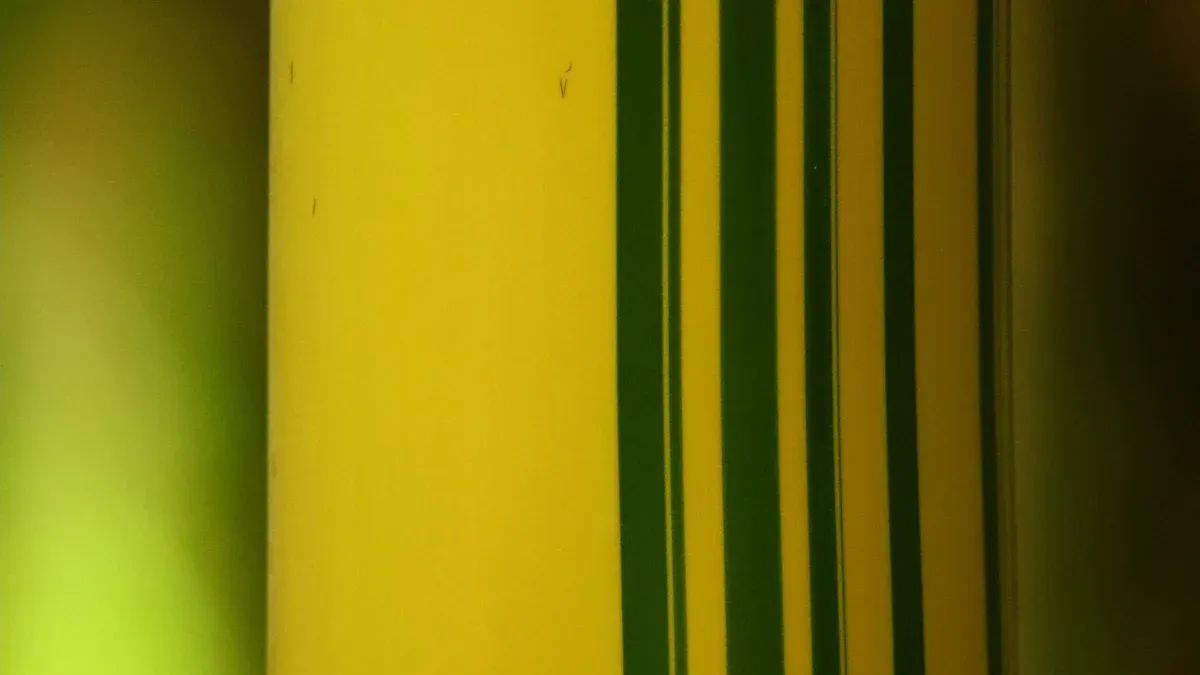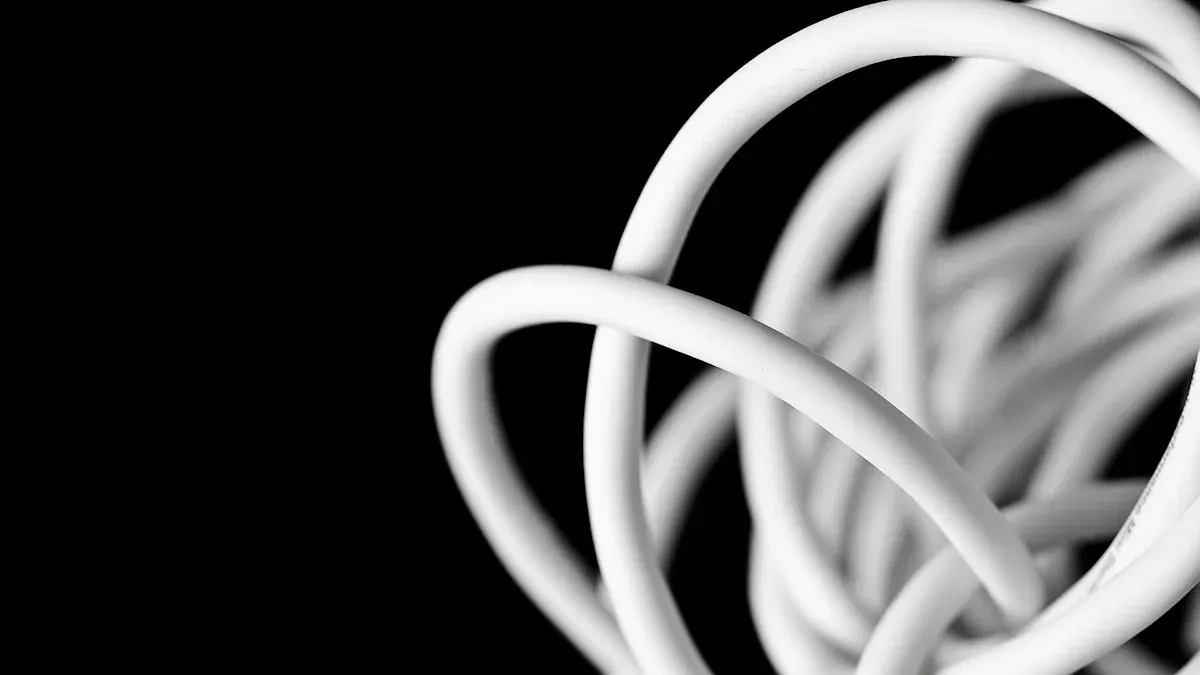How to Prevent PET Shrink Tubing from Cracking During Shrinking

To learn how to prevent PET shrink tubing from cracking during shrinking, start by using the right amount of heat, selecting high-quality tubing, and handling it gently. Excessive or uneven heat, poor-quality tubing, and rough treatment are common causes of cracks. Begin with tubing that suits your specific needs, apply consistent heat, and avoid pulling on the tubing. If you want to prevent PET shrink tubing from cracking during shrinking, prepare carefully and follow the proper steps.
Key Takeaways
Use good PET shrink tubing that meets safety rules. This helps stop cracks and makes strong seals.
Heat the tubing evenly. Keep the temperature between 70°C and 190°C. Try to keep it close to 150°C. This stops weak spots and keeps it from breaking.
Hold the tubing gently by the ends. Do not pull, twist, or stretch it when it is hot. This lowers stress on the tubing.
Get ready by cleaning the parts. Measure to make sure the tubing fits well. Store the tubing in a clean and dry place. This keeps it in good shape.
Follow each step with steady heat and careful handling. Let it cool for enough time. This makes the shrink wrap smooth, strong, and last longer.
Why Tubing Cracks

Heat Issues
You often see cracks in PET tubing when you do not control the heat during the shrink wrap process. Heat plays a major role in how well the tubing performs. If you use too much heat, the tubing can become weak or brittle. This weakness leads to cracks. If you do not apply heat evenly, you may notice wrinkles, bubbles, or weak spots. These defects can cause the shrink wrap to fail.
Always keep the temperature between 70°C and 190°C. The best results come when you use about 150°C.
Move your heat source slowly and evenly along the tubing. This helps you avoid overheating one spot.
Hold the heat gun or tool at a steady distance from the shrink wrap. This keeps the temperature even.
Test the heat on a small piece of shrink film before you start the full job.
When you follow these steps, you help the shrink wrap fit tightly without causing cracks. You also make sure the tubing keeps its strength and shape.
Mechanical Stress
Mechanical stress can also cause cracks in PET tubing. If you pull or stretch the tubing during the shrink wrap process, you put extra pressure on the material. This pressure can make the shrink film tear or split. You should avoid bending or twisting the tubing while it is hot. Hot shrink wrap is softer and more likely to crack under stress.
Use gentle hands when you handle the tubing. Hold the ends steady and do not force the shrink film into place. If you use clamps or fixtures, make sure they do not pinch or damage the tubing. When you treat the shrink wrap with care, you lower the risk of cracks and get a smooth, strong finish.
How to Prevent PET Shrink Tubing from Cracking During Shrinking
Choose Quality Tubing
You need to start with the right tubing if you want to know how to prevent pet shrink tubing from cracking during shrinking. High-quality tubing gives you better results and fewer problems. Look for tubing that meets strict standards, such as FDA Quality System Regulation, ISO 10993, and USP Class VI. These certifications show that the tubing is safe, strong, and reliable. UL certification and RoHS compliance also help you avoid fire, shock, and harmful substances. Tubing made in the USA often has better durability and fewer defects. Avoid stiff, shiny PVC plastics because they tear easily. Always check for cleanroom manufacturing and cross-linking, which make the tubing stronger and more flexible. When you choose the right tubing, you set yourself up for smooth shrink wrap and tight seals.
Tip: Always inspect the tubing for cracks or rough spots before you use it. Even a small defect can cause the shrink wrap to fail.
Prepare Tubing and Components
Proper preparation is key to how to prevent pet shrink tubing from cracking during shrinking. Clean the tubing and all device parts with approved cleaners and a lint-free cloth. Measure your parts with calipers to pick the right size tubing. The tubing should fit snugly, with no more than a 15% gap above the part’s diameter. Store your tubing in a dry, clean place to keep it in good condition. Before you start, line up your components and tubing so everything fits together smoothly. Use tools like needle-nose pliers or a soldering aid to hold the tubing and wire firmly. This step helps you avoid nicks or cuts that can cause the shrink wrap to split when heated.
Inspect and clean all parts.
Measure carefully for a tight fit.
Store tubing in a dry, dust-free area.
Use the right tools to hold and align parts.
Apply Heat Evenly
Even heat is essential for how to prevent pet shrink tubing from cracking during shrinking. Use a heat gun and move it slowly from one end of the tubing to the other. Do not let the heat stay in one spot for too long. Rotate the heat source around the tubing to make sure the shrink wrap tightens evenly. If you see bubbles or wrinkles, you may need to adjust your technique. Hold the ends of the tubing steady to control shrinkage and avoid stretching. For best results, use clamps or fixtures to keep everything in place. This method helps you get smooth, tight seals every time.
Note: Uneven heat can cause air bubbles, weak spots, or cracks in the shrink film. Always keep the heat moving and check your work as you go.
Control Temperature
Temperature control is a major factor in how to prevent pet shrink tubing from cracking during shrinking. Set your heat gun to a temperature between 70°C and 190°C. Most jobs work best at about 150°C. Use a heat gun with adjustable fan speed to avoid blowing the tubing out of place. Test the heat on a small piece of shrink film before you start the main job. If you use too much heat, the tubing can become brittle and crack. If you use too little, the shrink wrap will not seal tightly. Always follow the manufacturer’s recommendations for temperature and shrinking time.
Set the heat gun to the correct temperature.
Adjust fan speed for gentle airflow.
Test on scrap tubing first.
Watch for signs of overheating, like discoloration or smoke.
Use Proper Handling
Gentle handling is the final step in how to prevent pet shrink tubing from cracking during shrinking. Hold the ends of the tubing steady while you apply heat. Do not pull, twist, or stretch the tubing when it is hot. Use clamps or spring-loaded vice grips to keep connectors and tubing in place. Avoid nicking or cutting the ends, as even a small cut can cause the shrink wrap to tear like a zipper. After shrinking, let the tubing cool before you move or adjust it. If you need to stretch the heat shrink tube, do it gently and only after the tubing has cooled. This technique helps you get strong, smooth seals that last.
Callout: If you notice any cracks or rough spots after shrinking, inspect the seals and replace the tubing if needed. Good handling prevents most problems and keeps your shrink wrap looking professional.
Troubleshooting Tubing Cracks
Early Signs of Cracking
You can spot early signs of cracking if you know what to look for. Small lines or hairline fractures may appear on the surface of the PET shrink tubing. These cracks often start near the ends or where the tubing bends. You might notice a change in color, such as white streaks or cloudy spots. If you see bubbles or uneven shrinking, check for cracks right away. Listen for a snapping sound when the tubing cools. This noise can signal a break in the material.
Tip: Run your finger gently along the tubing. If you feel roughness or sharp edges, you may have a crack starting.
Quick Fixes
You can try a few quick fixes if you catch cracks early. Use a heat gun on a low setting to reflow the tubing gently. Move the heat evenly over the area. Do not overheat. If the crack is small, you can apply a clear adhesive or sealant made for plastics. This step helps stop the crack from spreading. For minor surface cracks, wrap a second layer of shrink tubing over the damaged area. This method adds strength and covers the flaw.
Reheat gently to smooth out small cracks.
Apply plastic-safe adhesive for tiny splits.
Add a second layer of tubing for extra support.
Note: These solutions work best for minor damage. Always check the tubing after repairs to make sure it stays strong.
When to Replace
You should replace PET shrink tubing if cracks grow larger or reach the full width of the tubing. If you see multiple cracks or the tubing feels brittle, replacement is the safest choice. Damaged tubing can fail during use and cause bigger problems. Good maintenance means checking your tubing often and replacing it before it breaks completely. Always keep spare tubing on hand for quick swaps.
Condition | Action |
|---|---|
Small, single crack | Try a quick fix |
Multiple or deep cracks | Replace tubing |
Tubing feels brittle | Replace tubing |
Callout: Do not risk using tubing with major cracks. Replacement keeps your project safe and reliable.
Prevention Checklist

Key Steps Recap
You can prevent PET shrink tubing from cracking by following a clear process. Start by choosing high-quality tubing that meets industry standards. Always inspect the tubing for any damage before you use it. Clean all parts and measure carefully to ensure a snug fit. Store your tubing in a dry, dust-free place to keep it in top condition.
When you apply heat, move the heat gun slowly and evenly. Rotate the heat source around the tubing for uniform shrinking. Set your heat gun to the correct temperature, usually around 150°C. Test the heat on a scrap piece first. Hold the ends of the tubing steady and avoid pulling or twisting while it is hot. Use clamps or fixtures to keep everything in place. Let the tubing cool before you handle it further. These steps help you create strong seals that last.
Tip: Always check your work as you go. If you see bubbles or wrinkles, adjust your technique right away.
Quick Reference
Here is a quick checklist you can use every time you work with PET shrink tubing:
Inspect tubing for cracks or rough spots
Clean and measure all parts
Store tubing in a dry, clean area
Use the right size tubing for a snug fit
Set heat gun to 150°C (test first)
Move heat source evenly and rotate around tubing
Hold ends steady; avoid stretching or twisting
Use clamps or fixtures for support
Let tubing cool before moving or adjusting
Check for smooth, tight seals after shrinking
Step | What to Do | Why It Matters |
|---|---|---|
Inspect Tubing | Look for damage | Prevents early cracks |
Apply Heat Evenly | Move and rotate heat source | Ensures strong seals |
Handle Gently | Hold steady, avoid stress | Keeps seals intact |
✅ Following this checklist helps you get reliable seals and reduces the risk of cracks every time.
You can stop PET shrink tubing from cracking if you get ready the right way, use the right heat, and pick good tubing. Studies show that cracks often happen when the heat is not even or the tubing is not good quality. One example showed that careful prep and picking the right tubing stopped the tubing from breaking. Always use the checklist and watch your steps closely. Most cracks will not happen if you do these things and use the best materials.
FAQ
What causes PET shrink tubing to crack most often?
You usually see cracks from too much heat, uneven heating, or poor-quality tubing. Mechanical stress, like pulling or twisting, also leads to cracks. Always check your technique and materials to avoid these problems.
Can you reuse PET shrink tubing after it cracks?
No, you should not reuse cracked PET shrink tubing. Cracks weaken the seal and reduce protection. Always replace damaged tubing to keep your project safe and reliable.
How do you know if you overheated the tubing?
You may notice discoloration, a burnt smell, or brittle spots. The tubing might shrink unevenly or develop bubbles. If you see these signs, lower the heat and test on scrap tubing first.
Is it safe to use a hair dryer instead of a heat gun?
You can use a hair dryer for small jobs, but it may not get hot enough for a tight seal. A heat gun gives you better control and more consistent results.
See Also
Selecting The Ideal Ultra-Thin PET Heat Shrink Tubing
Key Guidelines For Effective Use Of FEP Heat Shrink Tubing
Important Facts About PET Heat Shrink Tubing In Electronics
Comprehensive Steps To Pick The Correct Heat Shrink Tubing Size
How Heat Shrink Tubing Protects And Insulates Electrical Wiring

